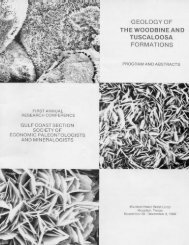Petroleum Systems of Deep-Water Basins - Gulf Coast Section SEPM
Petroleum Systems of Deep-Water Basins - Gulf Coast Section SEPM
Petroleum Systems of Deep-Water Basins - Gulf Coast Section SEPM
Create successful ePaper yourself
Turn your PDF publications into a flip-book with our unique Google optimized e-Paper software.
<strong>Gulf</strong> <strong>of</strong> Cadiz (Western Spain):<br />
Characterized by a Complex <strong>Petroleum</strong> System<br />
Luis Somoza<br />
ITGE: Geological Survey <strong>of</strong> Spain<br />
Rio Rosas 23 E-28003<br />
Madrid, Spain<br />
e-mail: Luis.Somoza@itge.es<br />
Bradley M. Battista<br />
Consultant<br />
1507 Dunbar Avenue<br />
Bay Saint Louis, Mississippi 39520<br />
U.S.A.<br />
Joan Gardner<br />
Code 7420<br />
Naval Research Labs<br />
4555 Overlook Drive<br />
Washington, D.C. 20375-5320<br />
U.S.A.<br />
e-mail: gardner@qur.nrl.navy.mil<br />
Allen Lowrie<br />
Consultant<br />
238 F. Z. Goss Road<br />
Picayune, Mississippi 39466-9458<br />
U.S.A.<br />
e-mail: alowrie@webtv.net<br />
Abstract<br />
The petroleum system is that series <strong>of</strong> interrelated processes by which hydrocarbons are generated and migrate to<br />
reservoirs from which they can be extracted commercially. The complex geology <strong>of</strong> the <strong>Gulf</strong> <strong>of</strong> Cadiz provides three<br />
separate heat sources for thermal maturation, while energetic downslope movement <strong>of</strong> crustal blocks has created reservoirs<br />
and traps that result from both structure and stratigraphic complexity.<br />
Westward extension by continental margin collapse <strong>of</strong> the Alboran Sea microplate in the Early Neogene has initiated<br />
large slump-block movements along the Iberic and Moroccan continental margins. Extensive allochthonous Late<br />
Cretaceous-Paleogene salt, deposited in a paleobasin having a western limit <strong>of</strong> 10°W to 12°W may underlie the<br />
slump-blocks at depths from 20 to 25 km and temperatures from 450° to 600°C, assuming 25°C/km gradient, and<br />
could serve as a lubricant for gravity-driven translation. Overall movement may exceed 400 km. The migrating<br />
blocks, operating as thin-skinned tectonics, and associated down-dip debris flows may be trapping mechanisms for<br />
hydrocarbons. Migrating debris covers an area as great as 90,000 km2, an area approximately equivalent to that covered<br />
by salt in the <strong>Gulf</strong> <strong>of</strong> Mexico.<br />
The eastern terminus <strong>of</strong> the Azores triple junction is well marked by shallow earthquakes (

















